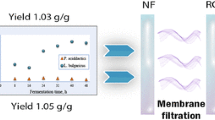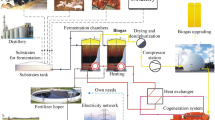Abstract
The aim of this study was to investigate the secondary fermentation of alcoholic green cider by Lactobacillus brevis and Oenococcus oeni in a membrane bioreactor so as to compare the performance of the two organisms to rapidly carry out the malolactic fermentation (MLF), an important step in reducing acidity and enhancing the flavor characteristics of the beverages. First, the growth of both organisms was intensified by using perfusion culture in a membrane bioreactor (MBR). O. oeni and L. brevis were grown up to 12.8 g dry cell weight (DCW) l−1 and 15.5 g DCW l−1 in the MBR. Secondly, the resultant cells were then used for the malolactic transformation of green cider in the MBR. The influences of the residence time in the MBR and the ethanol concentration of the green cider on the organic acid transformation were investigated. Both organisms showed a good tolerance against the acidic conditions (pH 3.0–4.0) and ethanol (90 g l−1). Good levels of malate removal in the MBR were achieved by both organisms but O. oeni was more tolerant to high ethanol concentrations and was capable of growth and malate removal in 130 g ethanol l−1 green cider. L. brevis malate removal was significantly inhibited above 110 g ethanol l−1. The MBR allowed the development of high concentrations of active cells capable of rapid MLF and could be achieved over a prolonged period and over a wide range of conditions thus allowing the control of malate transformation rate. Organism selection for the transformation will be governed by the desired beverage characteristics. There is considerable scope to optimize the process further both with the choice of organisms and the design and operation of the reactor. Rapid beverage maturation on a commercial scale may be possible using MBR and pure cultures of MLF lactic acid bacteria.








Similar content being viewed by others
References
Bibal B, Vayssier Y, Goma G, Pareilleux A (1991) High-concentration cultivation of Lactococcus cremoris in a cell-recycle reactor. Biotechnol Bioeng 37:746–754
Bourdineaud J-P, Nehmé B, Tesse S, Lonvaud-Funel A (2003) The ftsH gene of the wine bacterium Oenococcus oeni is involved in protection against environmental stress. Appl Environ Microbiol 69(5):2512–2520
Cogan TM (1987) Co-metabolism of citrate and glucose by Leuconostoc spp. effect on growth, substrates and products. J Appl Bacteriol 63:551–558
Crespo JPSG, Xavier AMRB, Barreto MTO, Gonçalves LMD, Almeida JS, Carrondo MJT (1992) Tangential flow filtration for continuous cell recycle culture of acidogenic bacteria. Chem Eng Sci 47:205–214
Drews A, Kraume M (2005) Process improvement by application of membrane bioreactors. Chem Eng Res Des 83:276–284
Elferink SJWHO, Krooneman J, Gottschal JC, Spoelstra SF, Faber F, Driehuis F (2001) Anaerobic conversion of lactic acid to acetic acid and 1,2-propanediol by Lactobacillus buchneri. Appl Environ Microbiol 67(1):125–132
Fortier L-C, Maréchal RT, Diviés C, Lee BH, Guzzo J (2003) Induction of Oenococcus oeni H+-ATPase activity and mRNA transcription under acidic conditions. FEMS Microbiol Lett 222:165–169
Gao C, Fleet GH (1994) The degradation of malic acid by high cell density suspensions of Lueconostoc oenos. J Appl Bacteriol 76:632–637
Gao C, Fleet GH (1995) Cell cycle membrane bioreactor for conducting malolactic fermentation. Aust J Grape Wine Res 1:32–38
Guerrini S, Bastianini A, Granchi L, Vincenzini M (2002) Effect of oleic acid on Oenococcus oeni strains and malolactic fermentation in wine. Curr Microbiol 44:5–9
Herrero M, García LA, Díaz M (2003) Malolactic conversion using a Oenococcus oeni strain for cider production; effect of yeast extract supplementation. J Ind Microbiol Biotechnol 30:699–704
Holownia AT (2008) Wastewater treatment in a microbial membrane bioreactor—a model of the process. Desalination 221:552–558
Kamoshita Y, Ohashi T, Suzuki T (1998) Improvement of filtration performance of stirred ceramic membrane reactor and its application to rapid fermentation of lactic acid by dense cell culture of Lactococcus lactis. J Ferment Bioeng 85(4):422–427
Kulozik U, Wilde J (1999) Rapid lactic acid production at high cell concentrations in whey ultrafiltrate by Lactobacillus helveticus. Enz Microbial Technol 24:297–302
Laera G, Pollice A, Saturno D, Giordano C, Sandulli R (2009) Influence of sludge retention time on biomass characteristics and cleaning requirements in a membrane bioreactor for municipal wastewater treatment. Desalination 236:104–110
Liu S-Q (2002) A review. Malolactic fermentation in wine—beyond deacidification. J Appl Microbiol 92:589–601
Liu S-Q, Asmundson RV, Holland R, Crow VL (1997) Acetaldehyde metabolism by Leuconostoc mesenteroides subsp. cremoris under stress conditions. Int Dairy J 7:175–183
Lonvaud-Funel A (1999) Lactic acid bacteria in the quality improvement and depreciation of wine. Antonie van Leeuwenhoek 76:317–331
Maicas S (2001) The use of alternative technologies to develop malolactic fermentation wine. Appl Microbiol Technol 56:35–39
Maicas S, Natividad A, Ferrer S, Pardo I (2000) Maloactic fermentation of wine with high densities of non proliferating cells Oenococcus oeni. World J Microbiol Biotechnol 16:805–810
Maréchal RT, Gaboriau D, Beney L, Diviés C (2000) Membrane fluidity of stress cells of Oenococcus oeni. Int Food Microbiol 55:269–273
Mårtensson O, Chasco M-D, Irastorza A, Öste R, Holst O (2003) Comparison of growth characteristics and exoploysaccharide formation of two lactic acid bacteria strains, Pedicoccu damnosus 2.6 and Lactobacillu brevis G-77, in an oat-based, nondairy medium. Lebensm Wiss Technol 36:353–357
Martinez G, Barker HA, Horecker BL (1963) A specific mannitol dehydrogenase from Lactobacillus brevis. JBC 238:1598–1603
Nedovic VA, Durieux A, Van Nedervelde L, Rosseels P, Vandegans J, Plaissant A-M, Simon J-P (2000) Continuous cider fermentation with co-immobilized yeast and Leuconostoc oenos cells. Enz Microbial Technol 26:834–839
Ng ANL, Kim AS (2007) A mini-review of modeling studies on membrane bioreactor (MBR) treatment for municipal wastewaters. Desalination 212:261–281
Nielsen JC, Richelieu M (1999) Control of flavor development in wine during and after malolactic fermentation by Oenococcus oeni. Appl Environ Microbiol 65:740–745
Osborne JP, Mira De Orduña R, Pilone GJ, Liu S-Q (2000) Acetaldehyde metabolism by wine lactic acid bacteria. FEMS Microbiol Lett 191:51–55
Pal P, Sikder J, Roy S, Giorno L (2009) Process intensification in lactic acid production: a review of membrane based processes. Chem Eng Process 48:1549–1559
Peterson WH, Fred EB (1920) Fermentation of fructose by Lactobacillus pentoaceticus, n. sp. JBC XLI:431–450
Pollice A, Laera G, Saturno D, Giordano C (2008) Effects of sludge retention time on the performance of a membrane bioreactor treating municipal sewage. J Mem Sci 317:65–70
Ramos A, Poolman B, Santos H, Lolkema JS, Konings WN (1994) Uniport of Anionic citrate and proton consumption in citrate metabolism generates a proton motive force in Leuconostioc oenos. J Bacteriol 176:4899–4905
Rodriguez SB, Amberg E, Thornton RJ, McLellan MR (1990) Malolactic fermentation in Chardonnay: growth and sensory effects of commercial strains of Leuconostoc oenos. J Appl Bacteriol 68:139–144
Sakamoto K, Margolles A, Van Veen HW, Konings WN (2001) Hop resistance in the beer spoilage bacterium Lactobacillus brevis is mediated by the ATP-binding cassette multidrug transporter HorA. J Bacteriol 183:5371–5375
Sakamoto K, Van Veen HW, Saito H, Kobayashi H, Konings WN (2002) Membrane-bound ATPase contributes to hop-resistance of Lactobacillus brevis. Appl Environ Microbiol 68:5374–5378
Savijoki K, Kahala M, Palva A (1997) High level heterologous protein production in Lactococcus and Lactobacillus using a new secretion system based on the Lactobacillus brevis S-layer signals. Gene 186:255–262
Soomro AH, Masud T, Anwaar K (2002) Role of lactic acid bacteria (LAB) in food preservation and human health—a review. Pak J Nutr 1:20–24
Suzuki T (1996) A dense cell culture system for microorganisms using a stirred ceramic membrane reactor incorporating asymmetric porous ceramic filters. J Ferment Bioeng 82:264–271
Suzuki T, Sato T, Kominami M (1994) A dense cell retention culture system using a stirred ceramic membrane reactor. Biotechnol Bioeng 44:1186–1192
Texeira H, Gonçalves MG, Rozés N, Ramos A, San Romão MV (2002) Lactobacillic acid accumulation in the plasma membrane of Oenococcus oeni: a response to ethanol stress. Microb Ecol 43:146–153
Tracey RP, Britz TJ (1989) Cellular fatty acid composition of Leuconostoc oenos. J Appl Bacteriol 66:445–456
Tracey RP, Britz TJ (1989) The effect of amino acids on malolactic fermentation by Leuconostoc oenos. J Appl Bacteriol 67:589–595
Van De Guchte M, Serror P, Chervaux C, Smokvina T, Ehrlich SD, Maguin E (2002) Stress responses in lactic acid bacteria. Antionie van Leeuwenhoek 82:187–216
Yasui T, Yoda K, Kamiya T (1995) Analysis of S-layer proteins of Lactobacillus brevis. FEMS Microbiol Let 133:181–186
Zhang D, Lovitt RW (2006) Performance assessment of malolactic fermenting bacteria Oenococcus oeni and Lactobacillus brevis in continuous culture. Appl Microbiol Biotechnol 69:658–664
Zhang D, Lovitt RW (2006) Review; strategies for enhanced malolactic fermentation in wine and cider maturation. J Chem Technol Biotechnol 81:1130–1140
Zhao Z, Chen L (2009) Dynamic analysis of lactic acid fermentation in membrane bioreactor. J Theor Biol 257:270–278
Author information
Authors and Affiliations
Corresponding author
Rights and permissions
About this article
Cite this article
Jung, I.S., Lovitt, R.W. A comparative study of an intensive malolactic transformation of cider using Lactobacillus brevis and Oenococcus oeni in a membrane bioreactor. J Ind Microbiol Biotechnol 37, 727–740 (2010). https://doi.org/10.1007/s10295-010-0716-7
Received:
Accepted:
Published:
Issue Date:
DOI: https://doi.org/10.1007/s10295-010-0716-7




